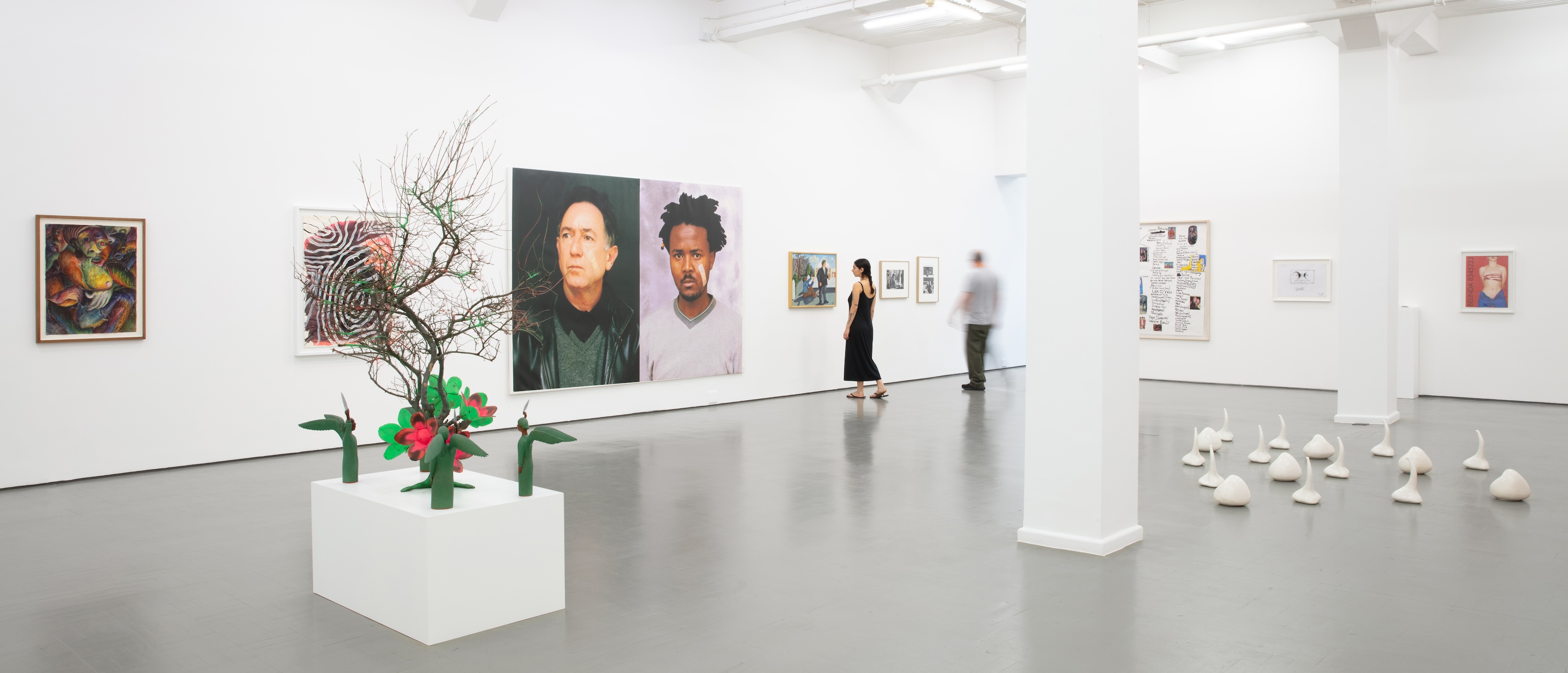Cape Town
18 October - 29 November 2025Imagined into being: South African art 1989 - 2004

Imagined into being: South African art 1989 - 2004, 2025, installation view
The 1990s were a time of vast changes in South Africa. As the country was imagined and wrought into being, so was its contemporary art. Orthodoxies crumbled, positions were staked out, and everything was up in the air. This exhibition grapples with the unfinished business of those years through the work of almost two dozen artists, covering roughly the period from Albie Sachs’ position paper ‘Preparing ourselves for freedom’ in 1989 to the ‘decade of democracy’ celebrations in the early 2000s. The selection is by necessity and by choice a deeply personal and idiosyncratic one, drawn from the diverging perspectives of the gallery’s multigenerational curatorial team, and echoes the cacophony of the time without attempting to encompass or define it. Omitting far more than it can include, this presentation is nonetheless a gesture that invites us to relook at those years that were foundational for contemporary art in South Africa, and have shaped the way we still look at and talk about art today.
The time period covered by this exhibition overlaps with what has been called ‘the golden age of biennales’, with most of the included artists exhibiting in the genre-defining mega-shows that took place in that era both locally and abroad. Featured works from the first and second Johannesburg Biennales – the latter described in Artforum as ‘the most important exhibition of the 1990s’ – include Belinda Blignaut’s mixed-media 8345223 and the films Alien by Minnette Vári and My Lovely Day by Penny Siopis. These are shown alongside the corporeal images of Berni Searle’s Red, Yellow, Brown from her Colour Me series which went on to receive the UNESCO award at the 7th Cairo Biennale. Across these works alone, a glimpse is provided into the dematerialised creative frameworks dominant in that era, while foregrounding the roots of the interplay between the individual and history that dominates discourse today.
The photographic propositions of Santu Mofokeng (also featured in the 1997 biennale) and Ruth Seopedi Motau (featured in the 1995 edition), reflecting black urban life outside of the paradigms of resistance and struggle, become progenitors of lens-based works that counter ethnographic violence with the rights to assertion and selfhood. Similarly, the selected works by Moshekwa Langa, created between 1996 (on his arrival in Cuba for the Havana biennale) and 2002 (when he took part in the biennales of São Paulo and Liverpool), take the form of flags for an unknown nation, a topographical study for an unknown geography and an elliptical list of thoughts and relations, reflecting the early stages of a politics of identity driven by the personal.
The silkscreens and performances of Steven Cohen (who featured in both editions of the Johannesburg Biennale – officially in the first, and with an unauthorised performance at the second) viscerally articulate the tensions of a nation on a precipice. Across the selected works he collages images of apartheid bureaucrats and symbols of white male masculinity with cartoons, stages an absurdist intervention at a voting station during the country’s second democratic elections, and casts a light on the surreal nature of the country’s inequalities. His unabashed actions of queering the status quo highlight the prevailing assumptions about race, class, gender and sexuality, generating the foment from which one can trace a particularly South African mode of institutional critique. Similarly, Thembinkosi Goniwe’s iconic Untitled (from Reclaiming the Gaze) work employs the adhesive bandage and a frank and idiomatic use of juxtaposition to reveal the everyday mechanics of racism.
Alongside the works venerated by the mainstream arts establishment, this exhibition features some ‘B-sides’ of visual history, including Wola Nani’s Aids awareness posters, an illustrative cloth work by Selinah Makwana, and a screening of The Luggage is Still Labelled, the 2004 documentary produced by Vuyile Voyiya and Julie McGee questioning transformation in South African art.
Across these works and more, Imagined into being: South African art 1989 - 2004 offers a window into a time that is long contested. For many in the South African artworld who lived through it, this period is a constant point of reference, and many of the debates initiated at the time rage on today, albeit with new nuances, angles and sensitivities. From this era uniquely marked by both body politics and conceptualism, definitive artistic languages developed and remain alive; at the same time, an entire generation of arts practitioners has come of age for whom this period is largely an abstraction. Imagined into being: South African art 1989 - 2004 combines these positions, alongside counterpoints by voices who were perhaps not the loudest at the time but are vital to weaving the tapestry of history.
Other exhibiting artists include Jane Alexander, David Goldblatt, Nicholas Hlobo, David Koloane, Senzeni Marasela, Sam Nhlengethwa, Sophie Peters, Jo Ractliffe, Robin Rhode, Usha Seejarim, Mmakgabo Helen Sebidi and Johannes Segogela, with special thanks to the Iziko South African National Gallery for works loaned from their collection.
The exhibition coincides with the gallery’s debut presentation at Art Basel Paris, showcasing the work of seven gallery and affiliated artists, highlighting the throughlines of the practitioners’ output from that time into the present.
The exhibition opens on Saturday 18 October, 10am to 1pm, concurrent with Thato Toeba's solo exhibition, sehlahla se tukang empa se sa che.

